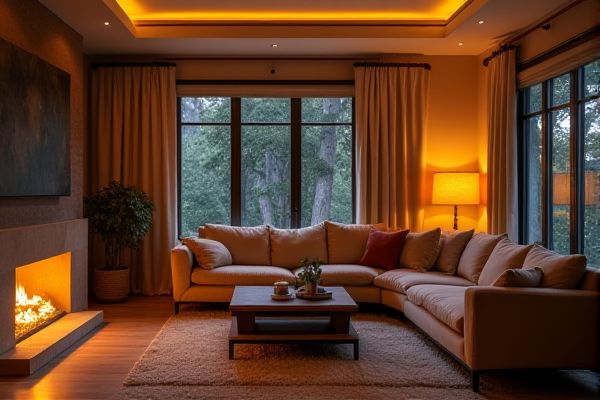
Accent lighting highlights specific objects or areas, creating visual interest and emphasizing textures, shapes, or colors, while ambient lighting provides overall illumination to ensure comfortable visibility and set the mood in a space. Understanding the differences between accent lighting vs ambient lighting can help you design a well-balanced and functional lighting scheme; explore the rest of the article to learn how to effectively combine both for your home or office.
Table of Comparison
| Aspect | Accent Lighting | Ambient Lighting |
|---|---|---|
| Purpose | Highlights specific objects or areas | Provides overall illumination for a space |
| Placement | Directed towards artwork, architectural features, or focal points | Installed in ceiling fixtures, wall sconces, or lamps |
| Light Intensity | Higher contrast with focused beams | Soft, even, and diffused light |
| Function | Enhances visual interest and texture | Creates mood and ensures visibility |
| Examples | Spotlights, track lighting, recessed directional lights | Ceiling-mounted fixtures, chandeliers, wall washers |
| Effect | Draws attention to specific features | Establishes ambient atmosphere in rooms |
Understanding Accent Lighting
Accent lighting highlights specific objects, architectural features, or artwork to create visual interest and depth within a space. It typically involves the use of spotlights, track lighting, or wall sconces to direct focused light on the chosen focal points, enhancing texture and color. Understanding accent lighting enables effective layering of light, complementing ambient lighting to establish mood and spatial definition.
Defining Ambient Lighting
Ambient lighting provides overall illumination in a space, creating a uniform level of brightness that ensures visibility and comfort. It is typically achieved through ceiling fixtures, recessed lights, or wall-mounted sconces that distribute light evenly without emphasizing specific areas. This foundational lighting supports other types like accent lighting, which highlights focal points or architectural features for visual interest.
Key Differences Between Accent and Ambient Lighting
Accent lighting highlights specific objects or architectural features, creating visual interest and depth with focused, directional light sources like spotlights or track lights. Ambient lighting provides overall illumination, ensuring your space is evenly lit and comfortable without harsh shadows, often achieved with ceiling fixtures, wall sconces, or diffused lamps. Understanding the key differences helps you balance functionality and aesthetics by combining accent and ambient lighting to enhance the mood and usability of your environment.
Purpose and Functions of Accent Lighting
Accent lighting directs focused illumination to highlight specific objects, such as artwork, architectural features, or decorative elements, enhancing visual interest and depth in a space. It creates contrast and shadows that add dimension, guiding the viewer's attention to focal points and enhancing the overall aesthetic. This type of lighting typically uses adjustable spotlights, track lighting, or wall-mounted fixtures to achieve precise control over brightness and direction.
Role of Ambient Lighting in Interior Design
Ambient lighting serves as the foundational illumination in interior design, creating a uniform light level that enhances overall visibility and comfort. It establishes the mood and atmosphere by providing a soft, diffused glow that reduces shadows and highlights the space's spatial dimensions. By complementing accent lighting, ambient lighting balances functionality and aesthetics, ensuring a cohesive and inviting environment.
Popular Applications for Each Lighting Type
Accent lighting is commonly used in art galleries, retail displays, and architectural features to highlight specific objects or areas, creating visual interest and depth. Ambient lighting serves as the primary source of illumination in living rooms, kitchens, and offices, providing uniform light levels for everyday activities and overall comfort. Both lighting types complement each other, with accent lighting adding dimension to the broader illumination provided by ambient lighting.
Pros and Cons: Accent Lighting vs Ambient Lighting
Accent lighting enhances specific areas or objects, creating visual interest and depth, but it can cause eye strain if overused and requires careful placement; ambient lighting provides overall illumination for comfortable visibility and mood setting, yet it may lack the dynamic impact of accent lighting. Accent lighting is ideal for highlighting artwork, architectural features, or focal points, offering flexibility in design, while ambient lighting ensures uniform brightness and reduces shadows, supporting basic functionality. Choosing between accent and ambient lighting depends on the desired atmosphere, space function, and lighting control preferences.
Impact on Mood and Atmosphere
Accent lighting enhances mood by highlighting specific areas or objects, creating focal points that draw attention and add drama. Ambient lighting provides a soft, uniform glow that establishes a comfortable, relaxing atmosphere throughout a space. The strategic use of both types balances visual interest and overall ambiance, influencing emotional responses and room functionality.
Choosing the Right Lighting for Each Space
Accent lighting highlights specific areas or objects, creating depth and visual interest in your space, making it ideal for showcasing artwork or architectural features. Ambient lighting provides overall illumination, ensuring a comfortable and functional environment by softly lighting the entire room. Understanding the purpose of each room helps you select the right balance between accent and ambient lighting to enhance both aesthetics and usability.
Combining Accent and Ambient Lighting for Optimal Results
Combining accent and ambient lighting enhances both functionality and aesthetics by balancing task illumination with atmosphere creation. Accent lighting highlights specific features such as artwork or architectural details, while ambient lighting provides overall brightness and comfort. Integrating adjustable fixtures and layered lighting strategies ensures a versatile environment adaptable to various activities and moods.
 homyna.com
homyna.com